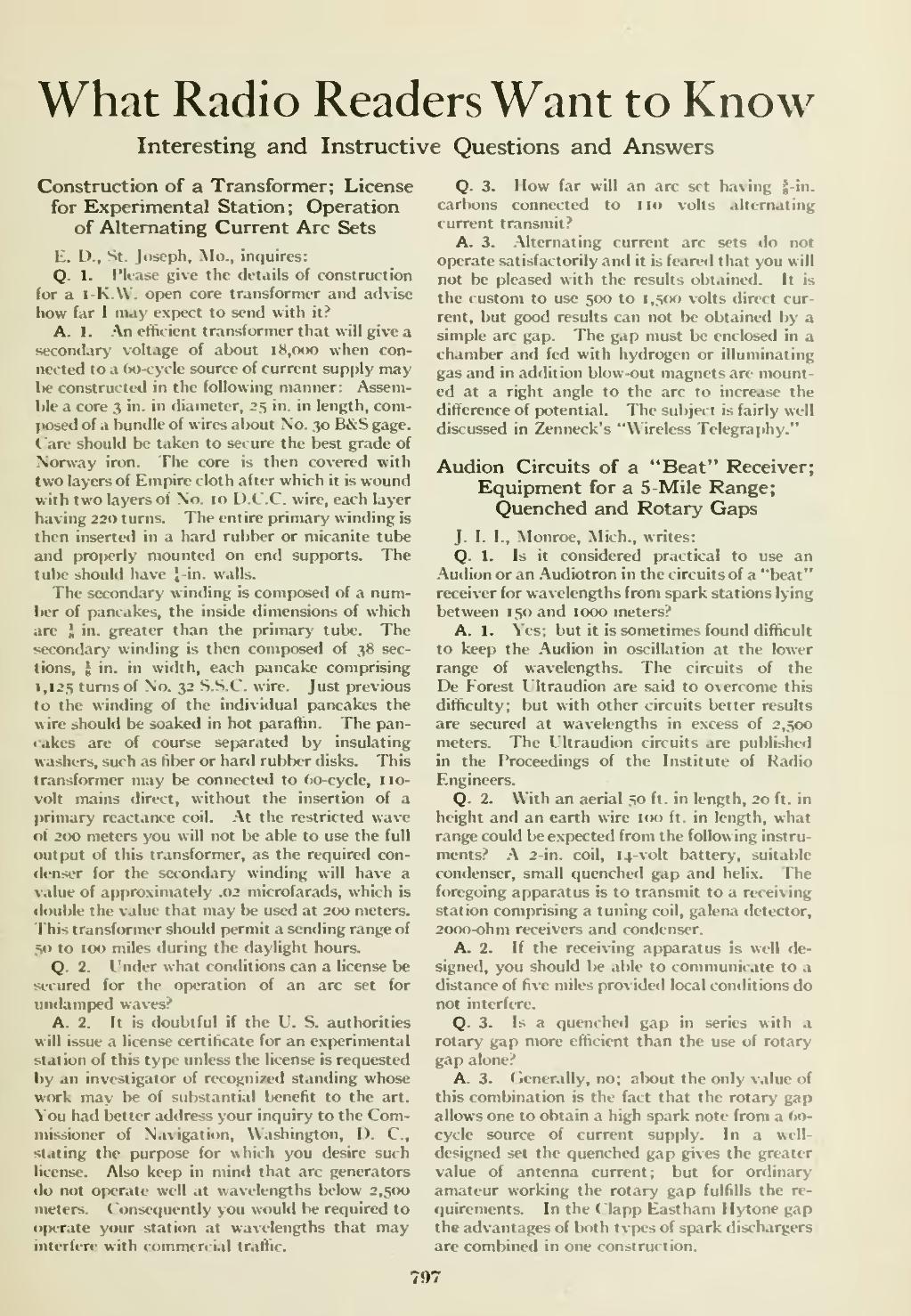What Radio Readers Want to Know
Interesting and Instructive Questions and Answers
��Construction of a Transformer; License
for Experimental Station; Operation
of Alternating Current Arc Sets
E. D., St. Jdsoph, Mo., iiKjuircs:
Q. 1. (Mease give the details of construction for a i-K.\V. open core transformer and advise how far I may expect to send with it?
A. 1. .^n efficient transformer that will give a secondary voltage of about 18,000 when con- nected to a 6<)-cycle source of current supply may l>e constructed in the following manner: Assem- ble a core ,> in. in diameter, 2.s in. in length, com- jiosed of a bundle of wires about \o. 30 B&S gage. Care shouUl be taken to secure the best grade of Norway iron. The core is then covered with two layers of Empire cloth after which it is wound with two layers of No. 10 U.C.C. wire, each layer having 220 turns. The entire primary winding is then inserted in a hard rubber or micanite tube and proi>erly mounted on end supports. The tube should have J-in. walls.
The secondary winding is composed of a num- ber of pancakes, the inside dimensions of which are J in. greater than the primary tube. The secondary winding is then composed of 38 sec- tions, J in. in width, each pancake comprising i,i2,s turns of No. 32 S.S.C. wire. Just previous to the winding of the individual pancakes the wire should be soaketl in hot paraffin. The pan- cakes are of course separated by insulating washers, such as fiber or hard rubber disks. This transformer may be connected to (>o-cycle, no- volt mains direct, without the insertion of a |)rimary reactance coil. At the restricted wave of 200 meters you will not be able to use the full output of this transformer, as the required con- denser for the secondary winding will have a \alue of api)roximately .02 microfarads, which is double the value that may be used at 200 meters. This transformer should [wrmit a sending range of 50 to 100 miles during the daylight hours.
Q. 2. Under what conditions can a license be secured for the operation of an arc set for undanipetl waves?
A. 2. It is doubtful if the U. S. authorities will issue a license certificate for an experimental station of this type imless the license is requested by an investigator of recognized standing whose work may be of substantial benefit to the art. \'ou had better address your inquiry to the Com- missioner of Navigation, Washington, D. C, slating the purpose for which you desire such license. Also keep in mind that arc generators do not operate well at wavelengths below 2,5t)o meters, ("onseciuently you would be required to operate your station at wavelengths that may interfere with commercial traffic.
��Q. 3. How far will an arc set having J-in. carbons connected to no volts alternating current transmit?
A. 3. Alternating current arc sets do not operate satisfactorily and it is feared that you will not be pleased with the results obtained. It is the custom to use 500 to 1,500 volts direct cur- rent, but good results can not be obtained by a simple arc gap. The gap must be enclosed in a chamber and fed with hydrogen or illuminating gas and in addition blow-out magnets are mount- ed at a right angle to the arc to increase the difference of potential. The subject is fairly well discussed in Zenneck's "Wireless Telegraphy."
Audion Circuits of a "Beat" Receiver;
Equipment for a 5 -Mile Range;
Quenched and Rotary Gaps
J. I. 1., Monroe, Mich., writes:
Q. 1. Is it considered practical to use an Audion or an Audiotron in the circuits of a '"beat" receiver for wavelengths from spark stations lying between 150 and 1000 meters?
A. 1. Yes; but it is sometimes found difficult to keep the Audion in oscillation at the lower range of wavelengths. The circuits of the De Poorest Ultraudion are said to overcome this difficulty, but with other circuits better results are secured at wavelengths in excess of 2,500 meters. The Ultraudion circuits are published in the Proceedings of the Institute of Radio Engineers.
Q. 2. With an aerial 50 ft. in length, 20 ft. in height and an earth wire 100 ft. in length, what range could be expected from the follow ing instru- ments? A 2-in. coil, 14- volt battery, suitable condenser, small quenched gap and helix. The foregoing apparatus is to transmit to a receiving station comprising a tuning coil, galena detector, 2ooo-ohm receivers and con<lenser.
A. 2. If the receiving apparatus is well de- signed, you should be able to conmiunicate to a distance of five miles provided local conditions do not interfere.
Q. 3. Is a quenched gap in series with a rotary gap more efficient than the use of rotary gap alone?
A. 3. Generally, no; about the only value of this combination is the fact that the rotary gap allows one to obtain a high spark note from a 60- cycle source of current supply. In a well- designed set the quenched gap gives the greater value of antenna current; but for ordinary amateur working the rotary gap fulfills the re- quirements. In the Clapp Eastham Hytone gap the advantages of both types of spark dischargers are combined in one construction.
��797
�� �
